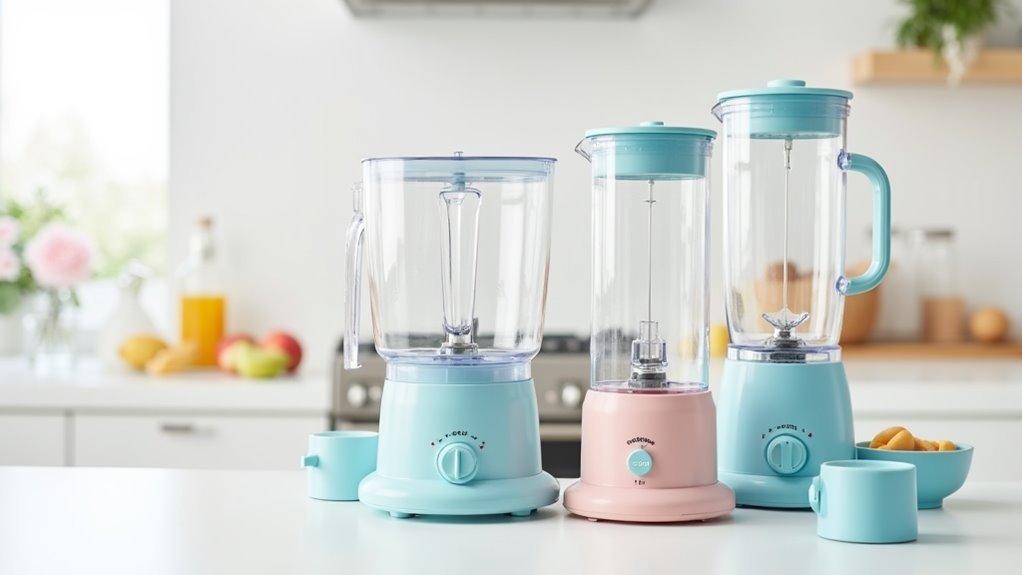In my 20 years of blending everything from soups to smoothies, I've learned that making baby food requires extra attention to safety. Trust me, those plastic containers from the old days weren't doing us any favors. Today's BPA-free blenders are a game-changer for whipping up fresh, wholesome meals for the little ones. Whether you're crushing steamed carrots or pureeing perfectly ripe pears, knowing your equipment is free from nasty chemicals makes all the difference. I remember when my neighbor handed down her ancient blender with questionable plastics – straight into the recycling it went. These days, manufacturers finally understand what we kitchen folks have known forever: quality materials matter, especially when preparing food for the smallest members of our families. Let's dig into what makes a blender truly safe for baby food, without any of that marketing fluff or fancy promises.
Understanding BPA Safety in Baby Food Preparation
When it comes to preparing baby food at home, understanding BPA safety isn't just a matter of preference – it's indispensable for our children's health. Recent studies have shown that even trace amounts of BPA can affect infant development, making our choice of Food Prep equipment vital.
We've seen a significant shift toward safer materials in baby food preparation, and we're now able to make better-informed decisions. When selecting a Blender for homemade baby food, we should prioritize materials like stainless steel and glass, which offer superior safety compared to plastics. While BPA-free alternatives like Tritan exist, they're not our foremost recommendation. Instead, we'll get the best results by choosing blenders with glass containers or stainless steel components, ensuring our little ones' food stays pure and chemical-free. High-performance blenders can provide the additional benefit of more effectively breaking down ingredients, ensuring smoother textures for infant nutrition.
Top-Rated BPA-Free Blender Materials and Components
Building on our safety-first approach, let's examine the top materials that make today's BPA-free blenders stand out. When choosing baby food makers and food processors, we've found that glass and stainless steel components lead the pack for safety and durability. Glass containers prevent chemical leaching while offering excellent thermal resistance, making them ideal for both hot and cold preparations.
For those seeking an easy-to-use option, handheld stick blenders with stainless steel blades provide exceptional durability and simple cleaning. While BPA-free plastics like Tritan offer a budget-friendly alternative, they don't match the proven safety record of glass and stainless steel. We recommend prioritizing blenders that feature these premium materials, especially for parts that directly contact your baby's food. High-performance blenders with motor power exceeding 1,000 watts often feature the most advanced BPA-free material technologies.
Essential Safety Features to Look for When Choosing a Blender

Safety features stand as the cornerstone of any high-quality baby food blender, with several critical elements deserving careful consideration. When we're making baby food, we'll want to guarantee our blenders for baby food include a glass blending jar or stainless steel steaming rack rather than plastic components that might contain harmful chemicals.
We should look for variable speed controls that prevent overprocessing, while keeping the unit small enough for easy storage and handling. The blender should be Easy to Clean, with removable parts that we can thoroughly sanitize.
Most importantly, we need transparent material disclosure from manufacturers about every component involved in blending. By choosing BPA-free certified materials like Tritan or tested sugar cane-based plastics, we're safeguarding our little ones from potential toxins during food preparation.
Glass Vs Plastic: Making the Right Choice for Your Baby
Although both glass and plastic blenders serve the purpose of preparing baby food, the choice between these materials considerably impacts our little one's health and safety. When comparing options like the BEABA Babycook Neo and Baby Brezza, we're seeing more parents opt for glass containers and stainless components.
While many manufacturers tout BPA-free materials, we've found that glass blending jars, like those in the Vitamix Ascent Series, offer superior safety benefits. Even with an immersion blender, it's best to avoid plastic when preparing fresh baby food. Glass provides a non-absorbent surface that won't leach chemicals into your little one's meals, and its durability justifies the initial investment. We're confident that choosing glass over plastic means fewer replacements and, most importantly, safer, cleaner food for our babies.
Cleaning and Maintenance Tips for BPA-Free Blenders

Maintaining your baby's blending equipment deserves the same attention as selecting the right materials. When making batches of baby food in your countertop blender or Baby Food Maker, proper cleaning guarantees your little ones get the safest nutrition possible.
| Component | Daily Care | Deep Clean |
|---|---|---|
| Container | Rinse after use | Weekly disassemble |
| Water Reservoir | Wipe clean | Monthly descale |
| Blade Assembly | Quick wash | Thorough soak |
| Base Unit | Spot clean | Monthly detail |
| Accessories | Handwash | Weekly sanitize |
We've found that easy cleaning starts with prompt attention after use. Take apart your blender's components and handwash them with mild soap, avoiding the dishwasher for BPA-free parts. Remember to dry everything thoroughly before reassembling, and store your Baby Food Maker in a cool, dry spot to make food safely next time.
Best Storage Practices for Homemade Baby Food
Once you've prepared nutritious homemade baby food, proper storage becomes essential for maintaining its freshness and safety. After steaming and blending your ingredients, we'll help you make the most of your food storage methods to preserve those healthy meals you've crafted at home.
- Transfer freshly prepared baby food into airtight containers, leaving space for expansion if freezing
- Use ice cube trays to create perfect individual servings, making it easy to thaw just what you need
- Label each container with the date and contents, whether it's pureed vegetables or frozen fruit
When storing homemade baby food, remember that refrigerated portions last 2-3 days, while frozen ones stay good for up to a month. Be sure to let hot steam dissipate before sealing containers, and always thaw frozen portions overnight in the refrigerator.
Frequently Asked Questions
What Kind of Blender Is Best for Baby Food?
We'd recommend a blender with adjustable speed settings, ample capacity, easy cleaning, strong power output, quiet operation, useful attachments, solid warranty, and minimal maintenance requirements for preparing your baby's food.
Is It Safe to Use a Blender for Baby Food?
We can safely use blenders for baby food when following proper safety precautions, choosing BPA-free materials, and maintaining clean equipment. It's an excellent way to control ingredients and nutritional content.
Can I Use My Ninja Blender to Make Baby Food?
We recommend using your Ninja blender's powerful features and adjustable speeds for baby food. It's safe, durable, and easy to maintain. With proper blending techniques and regular cleaning, you'll make perfect purees.
What Is the Best Machine for Making Baby Food?
While cost may concern you, we'd recommend the BEABA Babycook Neo for its nutrient retention, food texture control, and easy cleaning. Plus, its compact design, powerful motor, and dishwasher-safe components make customizable meal prep effortless.
Conclusion
When it comes to making your own baby food, having a BPA-free blender isn't just smart – it's essential. After years in the kitchen, I've learned that these workhorses need to be both safe and practical. You'll want to give those containers a good scrub after each use, store them properly, and always check for any wear and tear. Trust me, there's something deeply satisfying about turning fresh ingredients into smooth, wholesome purees in equipment you know is safe. Just remember to keep those blending containers away from heat and harsh detergents to maintain their BPA-free integrity. Once you get into the rhythm of it, you'll wonder why you ever considered store-bought baby food in the first place.

